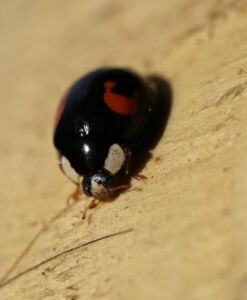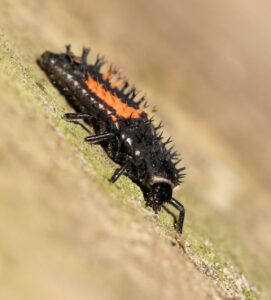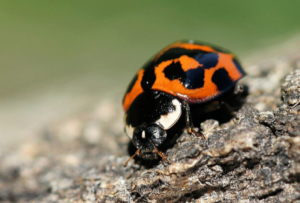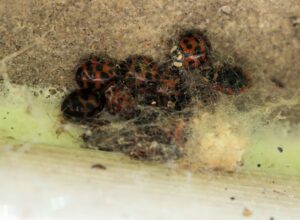The Harlequin Ladybird
An introduction to the Harlequin Ladybird Harmonia axyridis – a new species of beetle for the FBOG recording area
Alien species are of considerable conservation concern due to the pressures that they can exert on native fauna and flora. In 2013 the FBOG recording area had its first, somewhat overdue, record of the Harlequin Ladybird (IR et al). The species has been present along the Yorkshire coastal belt from at least 2007 (pers obs.), with a colony at Flamborough and an abundance in the Scarborough area.
It would seem most likely that the species has been present in Filey in low numbers from a similar time period but unrecorded and overlooked. The wet summers of 2011 and 2012 saw a marked reduction in ladybird abundance and diversity within the recording area, and is likely to have curtailed any early colonisation attempts by this species.

The two-spotted melanistic form of the Harlequin Ladybird – Harmonia axyridis forma conspicua

The larvae are typical of other Harmonia species, and are large aggressive creatures
The Harlequin Ladybird has been described as the fastest spreading invasive insect in Europe. It is a relatively recent addition to the United Kingdom’s fauna, first reported in 2003 from the south coast. This species originates from eastern Asia, but its route into the UK actually came from eastern North America, where it is equally invasive and is now recognised as the most abundant species of ladybird on that continent. Originally introduced into the states as early as 1916 as a means of biological control, specifically on soybean aphids, the species spread rapidly across the continent and indeed across much of the world wherever suitable climate and conditions occur.
The species now occupies much of the United Kingdom with records as far north as Orkney. The spread into the FBOG recording area was an unfortunate but inevitable event. The species is a large, aggressive generalist which easily outcompetes and predates most of our native ladybird fauna. Harlequins are a species which takes full advantage of urban and sub-urban habitats, owing to their higher mean temperatures and the abundance of hibernacula.
Searching parks, gardens and green areas around Filey town will undoubtedly turn up increasing numbers of records for this species. Harlequins are notably arboreal, with a particular affinity for both mature Sycamore Acer pseudoplatanus and Lime Tilia spp. trees, and to a lesser extent other Acer species such as Field Maple A. campestre and Norway Maple A. platanoides. These species generally have high aphid yields, and crucially retain leaves late into the year, hence their popularity with Phylloscopus warblers and titmice.
Harlequin ladybirds share a similar diet to that of the familiar Seven-spot ladybird Coccinella septempunctata and Two-spot Ladybird Adalia bipunctata, with a large proportion of the diet comprising aphids (greenfly) and coccids (scale insects), with a range of other insects also eaten including other ladybirds (sometimes even cannibalism).

The more typical colour form Harmonia axyridis forma succinea
The Harlequin is not one of the easiest ladybirds to identify for the beginner due to its complexity of colour morphs and variations within each morph.
This has led to names such as the Multicoloured Asian Ladybird across parts of its range. The species generally occurs in three distinct morphs in Britain; ‘succinea‘ – yellow/orange/red background colour with black spots, while ‘spectabilis‘ and ‘conspicua‘ are both black with four or two red spots respectively.

The species is typically gregarious around hibernation time, with groups building up around houses and buildings.
By Dan Lombard
